Comments / Questions (15)
![]() Aleksandra wrote:
Aleksandra wrote:
Dzień dobry nie rozumiem jak zamykać oczka w czapce - wykonuje rozmiar 3/5 lat. Mam w sumie zamknąć 40 oczek, 5 w pierwszym okrążeniu. Nie rozumiem jak ma się rozłożyć zamykanie tych kolejnych 35. Chodzi dokładnie o ten fragment: „Zamykać tak samo w sumie 3-2-5-3 razy co 2 okrążenia i 4-6-3-7 razy w każdym okrążeniu = zostaje 60-60-54-48 oczek.” Proszę o pomoc!
20.11.2023 - 13:20DROPS Design answered:
Witaj Olu, zamykasz oczka tak samo (przerabiać aż zostaje 2 oczka przed markerem, przerobić 2 oczka razem na prawo) 2 razy co 2 okrążenia i 6 razy w każdym okrążeniu (8 okrążeń z zamykaniem oczek x 5 zamkniętych oczek w okrążeniu = 40 zamkniętych oczek) = zostaje 60 oczek w przerabianym rozmiarze. W każdym okrążeniu zamykasz 5 oczek, tylko zamykasz oczka w różnej częstotliwości (co 2 okrążenia lub w każdym okrążeniu). Pozdrawiamy!
20.11.2023 - 16:06
![]() Line Normandeau wrote:
Line Normandeau wrote:
Moufles 7e rang: *2 m ensembles, 1 jeté * 8e rang: tout à l’endroit Ça fait des grands trous. Qu’est-ce que je ne comprend pas?
30.08.2023 - 19:56DROPS Design answered:
Bonjour Mme Normandeau, ce tour ainsi tricoté va permettre de créer une bordure picot quand on va plier le bas au niveau précisément de ce tour, tout comme nous le montrons dans cette vidéo - si vous trouvez que vos trous sont quand même trop grands, essayez de bien serrer le fil sur ce tour (ou bien utilisez des aiguilles plus fines juste pour ce tour). Bon tricot!
31.08.2023 - 09:02
![]() Kerstin Igen wrote:
Kerstin Igen wrote:
Först nu tittade jag på instruktionsvideon som hör till tummarkeringen. Stickade förut vänstervanten och klippte av tråden som det stod i beskrivningen. För högervanten stod inget om att klippa av tråden. Så nu tittade jag efter vad intruktionsvideon visade: NEJ, man behöver inte alls klippa av tråden! Jag stickar just nu högervanten och gjorde som videon visade, Hur bra som helst och två lösa trådar mindre att fästa. Alltså bör texten "klipp av tråden" tas bort.
30.05.2022 - 19:01
![]() Kerstin wrote:
Kerstin wrote:
Ett litet påpekande: I tummarkeringen för vänster tumme står "klipp av tråden" och att sedan sticka med avvikande färg för själva markeringen. I beskrivningen för höger tumme har man missat att skriva ut "klipp av tråden". Kan kanske vara lite förvirrande för ovana stickare.
30.05.2022 - 18:35
![]() Lucia Battisti wrote:
Lucia Battisti wrote:
Buongiorno vorrei realizzare il cappello per un bimbo di 6 mesi con baby alpaca silk quanti punti devo mettere? Grazie
05.12.2021 - 14:45DROPS Design answered:
Buonasera Lucia, per un'assistenza così personalizzata può rivolgersi al suo rivenditore DROPS di fiducia. Buon lavoro!
06.12.2021 - 19:44
![]() Jane Beales wrote:
Jane Beales wrote:
I am stuck on the thumb. I have seven stitches on my coloured thread and am asked to make one stitch each side of the thumb. 7+2 =9 but the pattern says I now have 16 stitches. Please help!
18.11.2021 - 00:11DROPS Design answered:
Dear Mrs Beales, the 7 sts for the thumb were worked with a scrap yarn, you then pull out this scrap yarn so that you get 7 sts on each side (from the round worked with the scrap yarn + the round after) = 14 sts in total + 1 st picked up on each side of these 7 sts = 16 sts. This video shows how to work with a loose/scrap yarn and how to pick up sts afterwards and should help you to understand how to work thumb. Happy knitting!
18.11.2021 - 08:49
![]() Lilli wrote:
Lilli wrote:
Måste man inte lägga upp nya maskor bakom de som man stickar upp på en hjälptråd? Låter väldigt konstigt att klippa av tråden och fortsätta sticka runt. Vilket antal maskor stickar man runt på?
28.10.2021 - 18:38
![]() Gunilla Edin wrote:
Gunilla Edin wrote:
Hej. När jag stickat det antal maskor storleken visar innan jag ska sticka in den avvikande tråden för tumöppningen, ska jag då klippa av garnen jag stickar vanten med? Tack på förhand.
28.09.2021 - 19:27DROPS Design answered:
Hej Gunilla. Ja det stämmer (för att slippa ha trådar där vid tummen på insidan av vanten). Mvh DROPS Design
29.09.2021 - 09:34
![]() Charlotte Hållén Johansson wrote:
Charlotte Hållén Johansson wrote:
Hej, det enklaste är nog om jag kan skicka en bild. Det syns ju först när man kommer till de vita kryssen. Men det är redan från start. Som sagt så sa "Yll och Tyll" att de får likadant, även på tröja, så det måste vara något vi inte fattar =) Det är som att när man kommer runt så är man en maska för högt upp, svårt att förklara. Jag väntar på godkännande i er Facebook-grupp, kan lägga en bild där när jag blir insläppt. Charlotte
17.09.2021 - 09:38DROPS Design answered:
Hej Charlotte. Så bra, då kan du säkert få hjälp där. Om det är precis vid övergången till nytt varv som du får ett hack, så har vi en video som visar hur man kan undvika detta här. Mvh DROPS Design
17.09.2021 - 12:30
![]() Charlotte Hållén Johansson wrote:
Charlotte Hållén Johansson wrote:
Hej, jag har problem med mönstret, det blir förskjutet hela tiden. Jag har stickat om samma vante 4 gånger. När jag frågade i butiken där jag köpte mönstret så sa det att det är så med DROPS mönster. Det var samma med tröjor de stickade. Men det här låter ju väldigt konstigt? Kan jag skicka en bild till er för att få hjälp? Tack på förhand!
17.09.2021 - 07:33DROPS Design answered:
Hej Charlotte. Mönstret ska inte bli förskjutet, så jag vet inte riktigt varför det blir så för dig. Är det redan i början av diagrammet du får problem eller när blir det så? Mvh DROPS Design
17.09.2021 - 09:24
North Star Set#northstarset |
|||||||
 |
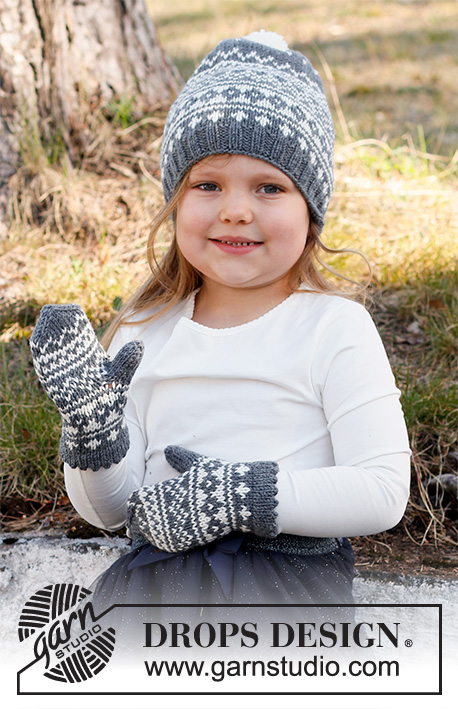 |
||||||
Knitted hat and mittens for children in DROPS Merino Extra Fine. The whole set is worked with Nordic pattern. Sizes 2 – 12 years.
DROPS Children 37-3 |
|||||||
|
------------------------------------------------------- EXPLANATIONS FOR THE PATTERN: ------------------------------------------------------- PATTERN: Hat and mittens: See diagrams A.1 and A.2. The whole pattern is worked in stockinette stitch. KNITTING TIP-1: To avoid the garment losing its elasticity when working the pattern, it is important the strands at the back are not tight. Increase a needle size when working pattern if this is a problem. KNITTING TIP-2 (for mittens): The length you work before the start of the thumb-opening can be adjusted by working more or fewer rounds before marking the opening. DECREASE TIP-1 (for top of hat): Work until there are 2 stitches left before the marker, knit 2 together (= 1 stitch decreased). DECREASE TIP-2 (for top of mitten): Start 3 stitches before the marker thread, knit 2 together, knit 2 (marker thread sits between these 2 stitches), slip 1 stitch as if to knit, knit 1 and pass the slipped stitch over the knitted stitch (= 2 stitches decreased at the marker thread). DECREASE TIP-3 (for thumb): Start 2 stitches before the marker thread, knit 2 together, marker thread, slip 1 stitch as if to knit, knit 1 and pass the slipped stitch over the knitted stitch (= 2 stitches decreased). ------------------------------------------------------- START THE PIECE HERE: ------------------------------------------------------- HAT – SHORT OVERVIEW OF THE PIECE: The piece is worked in the round with short circular needle, bottom up. Change to double pointed needles when necessary. HAT: Cast on 96-100-104-108 stitches with short circular needle size 3 mm = US 2,5 and medium grey. Knit 1 round, then work rib in the round (= knit 2 / purl 2) for 3 cm = 1⅛". Change to short circular needle size 3.5 mm = US 4. Read KNITTING TIP-1 and work A.1 in the round (= 24-25-26-27 repeats of 4 stitches). REMEMBER THE KNITTING GAUGE! When A.1 has been completed, work A.2 (= 24-25-26-27 repeats of 4 stitches). Work until the piece measures 17-18-18-19 cm = 6¾"-7"-7"-7½" and at the same time decrease 1-0-2-0 stitches evenly on the last round = 95-100-102-108 stitches. Insert 5-5-6-6 markers in the piece with 19-20-17-18 stitches between each marker. Work stockinette stitch with medium grey. AT THE SAME TIME on the next round decrease 1 stitch before each marker - read DECREASE TIP-1 = 5-5-6-6 stitches decreased. Decrease like this every 2nd round a total of 3-2-5-3 times and then every round a total of 4-6-3-7 times = 60-60-54-48 stitches left. Work 3 rounds of stockinette stitch where all stitches are knitted together 2 and 2 on all 3 rounds = 8-8-7-6 stitches left. Cut the strand, pull it through the remaining stitches, tighten and fasten well. The hat measures approx. 21-22-23-24 cm = 8¼"-8¾"-9"-9½" from the top down. ASSEMBLY: Make a pom pom using off-white and approx. 4 cm = 1½" = US 4 in diameter. Fasten to top of hat. ------------------------------------------------------- MITTENS – SHORT OVERVIEW OF THE PIECE: The piece is worked in the round with double pointed needles, bottom up. LEFT MITTEN: Cast on 28-32-36-40 stitches with double pointed needles size 3.5 mm = US 4 and medium grey. Work 6 rounds of stockinette stitch for the lining. The next round is worked as follows: * Knit 2 together, 1 yarn over *, work from *-* to end of round (= folding edge). The piece is now measured from this folding edge! Work 6 rounds of stockinette stitch with medium grey. REMEMBER THE KNITTING GAUGE! Read KNITTING TIP-1 and work A.1 in the round (= 7-8-9-10 repeats of 4 stitches). When A.1 has been completed, work A.2. Then repeat A.2 in height to finished length. AT THE SAME TIME when the piece measures approx. 6-8-9-10 cm = 2⅜"-3⅛"-3½"-4" from the folding edge, work a marker for the thumb-opening as follows – read KNITTING TIP-2: Work 6-8-9-11 stitches in pattern as before, cut the strand. Work 6-6-7-7 stitches in stockinette stitch for the thumb-opening using a color which stands out from the rest of the piece, then work the remaining 16-18-20-22 stitches in pattern as before. Continue the pattern as before over all stitches until the piece measures 12-14-15-18 cm = 4¾"-5½"-6"-7" from the folding edge (you have worked 6-6-6-8 cm = 2⅜"-2⅜"-2⅜"-3⅛" from the thumb-opening). There is now approx. 2-2-3-3 cm = ¾"-¾"-1⅛"-1⅛" to finished length; try the mitten on and work to desired length. Insert 1 marker thread at the beginning of the round and 1 marker thread after 14-16-18-20 stitches. Work stockinette stitch in the round with medium grey. AT THE SAME TIME on the first round decrease on each side of the 2 marker threads – read DECREASE TIP-2 (= 4 stitches decreased). Decrease like this every round a total of 6-7-8-9 times = 4 stitches left. Cut the strand, pull it through the remaining stitches, tighten and fasten well. The mitten measures approx. 14-16-18-21 cm = 5½"-6¼"-7"-8¼" from the top down to the folding edge. THUMB: Remove the colored strand used for the 6-6-7-7 stitches in the thumb-opening. Divide these stitches onto double pointed needles size 3.5 mm = US 4 and knit up 1 stitch on each side of the thumb using medium grey = 14-14-16-16 stitches. Work stockinette stitch in the round with medium grey. When the thumb measures approx. 3-3½-4-4½ cm = 1⅛"-1¼"-1½"-1¾", insert 1 marker thread on each side of the thumb. There is now approx. 1 cm = ⅜" to finished length; try the mitten on and work to desired thumb-length. On the next round decrease on each side of both marker threads – read DECREASE TIP-3 (= 4 stitches decreased). Decrease like this every round a total of 2 times = 6-6-8-8 stitches left. Cut the strand, pull it through the remaining stitches, tighten and fasten well. RIGHT MITTEN: Cast on 28-32-36-40 stitches with double pointed needles size 3.5 mm = US 4 and medium grey. Work 6 rounds of stockinette stitch for the lining. The next round is worked as follows: * Knit 2 together, 1 yarn over *, work from *-* to end of round (= folding edge). The piece is now measured from this folding edge! Work 6 rounds of stockinette stitch with medium grey. Remember KNITTING TIP-1 and work A.1 in the round (= 7-8-9-10 repeats of 4 stitches). When A.1 has been completed, work A.2. Then repeat A.2 in height to finished length. AT THE SAME TIME when the piece measures approx. 6-8-9-10 cm = 2⅜"-3⅛"-3½"-4" from the folding edge, work a marker for the thumb-opening as follows – remember KNITTING TIP-2: Work 16-18-20-22 stitches in pattern as before, 6-6-7-7 stitches in stockinette stitch for the thumb-opening, using a color which stands out from the rest of the piece, then work the remaining 6-8-9-11 stitches in pattern as before. Continue the pattern as before over all stitches until the piece measures 12-14-15-18 cm = 4¾"-5½"-6"-7" from the folding edge (you have worked 6-6-6-8 cm = 2⅜"-2⅜"-2⅜"-3⅛" from the thumb-opening; match the left mitten). Insert 1 marker thread at the beginning of the round and 1 marker thread after 14-16-18-20 stitches. Work stockinette stitch in the round with medium grey. AT THE SAME TIME on the first round decrease on each side of the 2 marker threads – remember DECREASE TIP-2 (= 4 stitches decreased). Decrease like this every round a total of 6-7-8-9 times = 4 stitches left. Cut the strand, pull it through the remaining stitches, tighten and fasten well. The mitten measures approx. 14-16-18-21 cm = 5½"-6¼"-7"-8¼" from the top down to the folding edge. THUMB: Work the thumb in the same way as on the left mitten. ASSEMBLY: Fold the lining to the wrong side and sew down with small neat stitches. |
|||||||
Diagram explanations |
|||||||
|
|||||||

|
|||||||
Have you finished this pattern?Tag your pictures with #dropspattern #northstarset or submit them to the #dropsfan gallery. Do you need help with this pattern?You'll find 18 tutorial videos, a Comments/Questions area and more by visiting the pattern on garnstudio.com. © 1982-2025 DROPS Design A/S. We reserve all rights. This document, including all its sub-sections, has copyrights. Read more about what you can do with our patterns at the bottom of each pattern on our site. |
|||||||







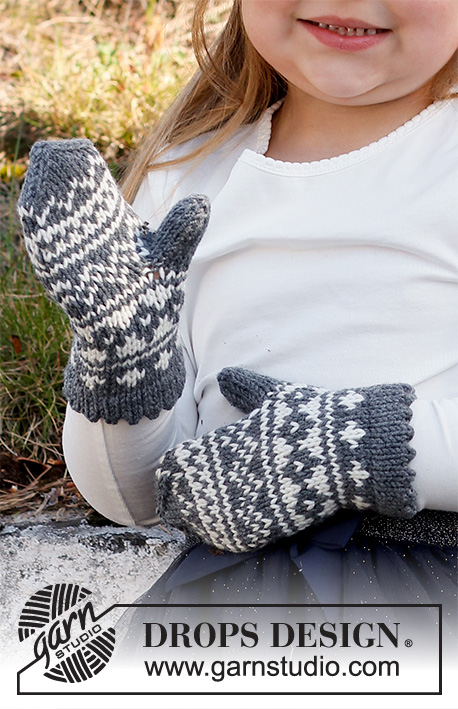
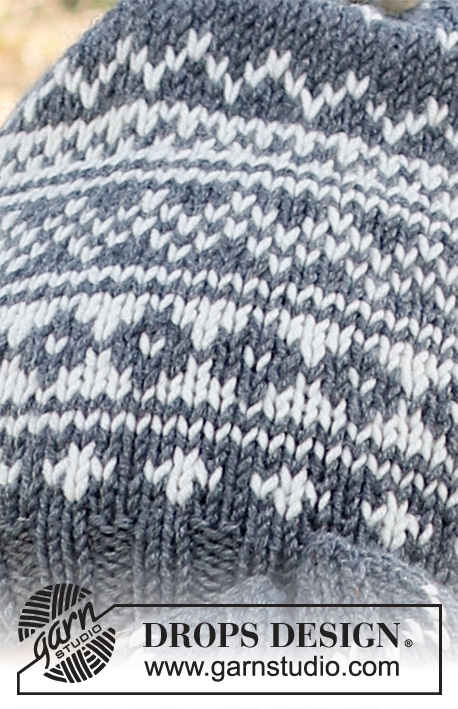

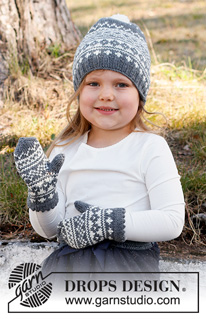
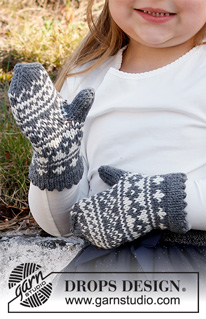
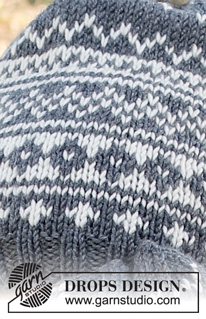






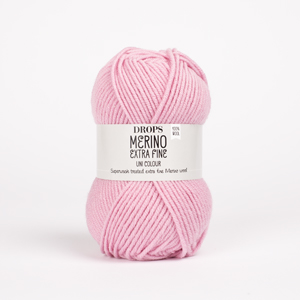
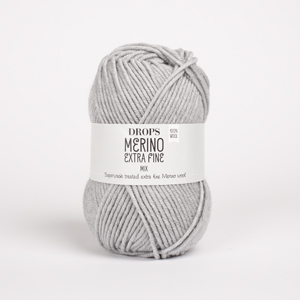
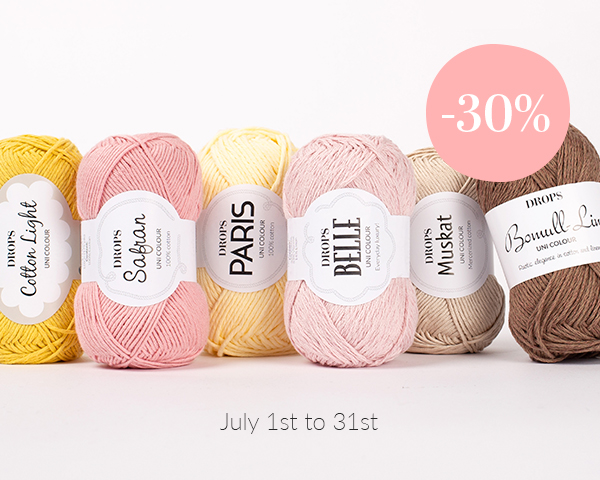
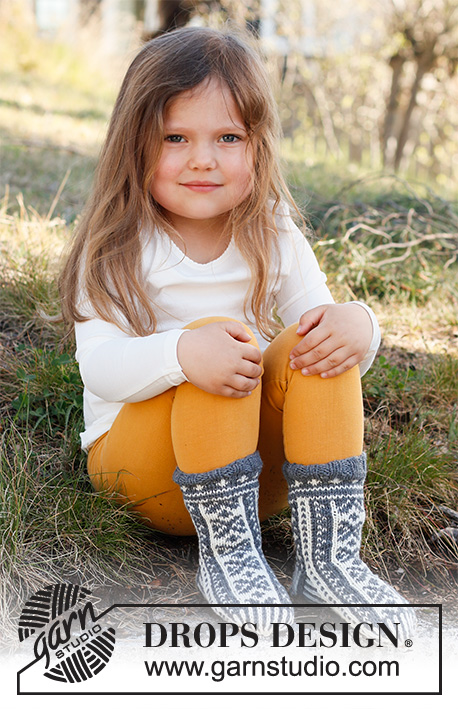



































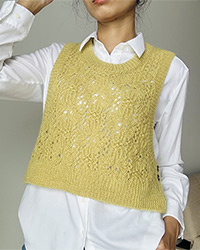

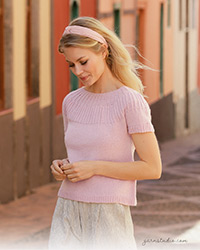
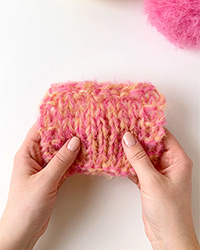
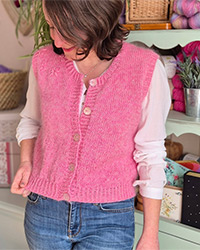
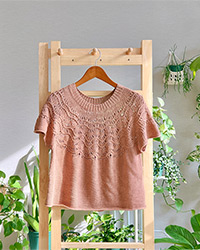
Post a comment to pattern DROPS Children 37-3
We would love to hear what you have to say about this pattern!
If you want to leave a question, please make sure you select the correct category in the form below, to speed up the answering process. Required fields are marked *.